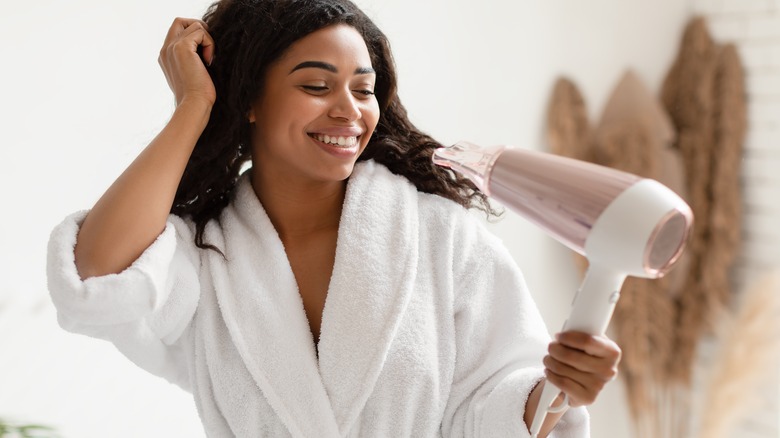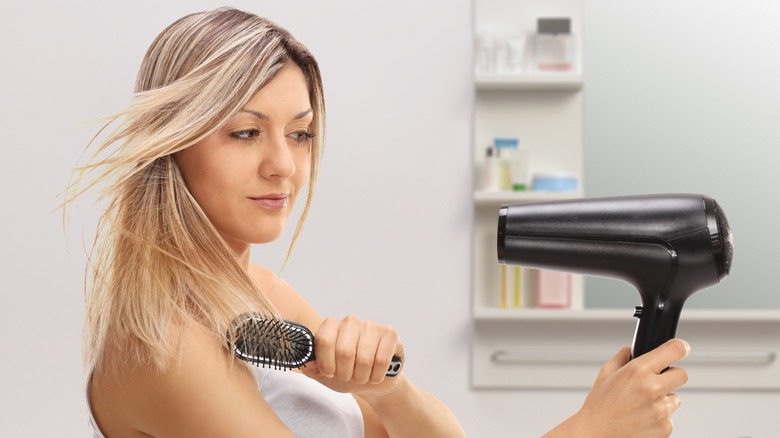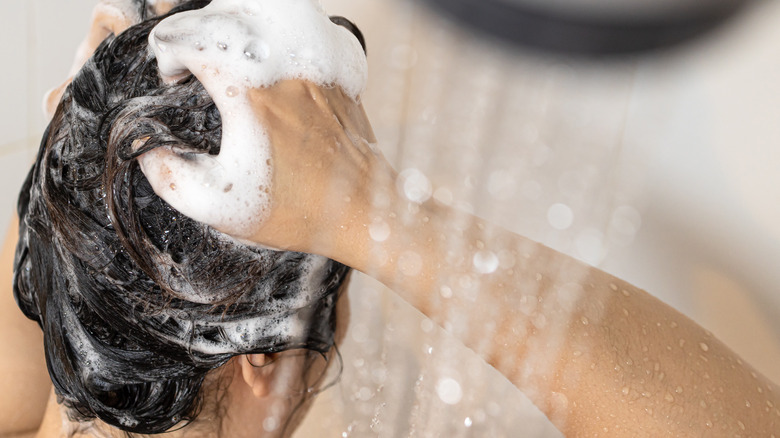Why You Should Be Using Your Hairdryer With Your Dry Shampoo
Dry shampoo might seem like a new, revolutionary product that has changed the hair care game, but it has been around for longer than you might think. New Beauty notes that chemist and pharmacist Hans Schwarzkopf actually created a scented hair wash powder back in 1903. He eventually launched a liquid shampoo in 1927, but hair washing and shampooing weren't yet the norm.
Today, dry shampoo has become a lifesaver for anyone who is serious about maintaining the health of their tresses. Overwashing your hair can remove the sebum (or oil) that your scalp creates, which is essential to the health of your locks. If you overuse shampoo, you might experience hair that is dry, dull, and challenging to style.
Dry shampoo can be an effective alternative if you want to eliminate dirt and excess oil from your scalp without undergoing a full wash. Dry shampoo is typically composed of starch or alcohol that helps absorb oil from your scalp and hair. While it isn't meant to be a full-time replacement for washing your hair with shampoo, it can be an ideal option if you simply need to freshen up. This being said, dry shampoo works best when used correctly. In combination with a hairdryer, here is how to take your hair maintenance game to the next level.
How to effectively use your hairdryer with dry shampoo
To begin, apply your dry shampoo to your scalp and hair, making sure to get it into the roots. As you normally would after using it, give the dry shampoo a couple of minutes to work its magic and absorb excess oil, grease, and dirt. Now, it's time to reach for your hairdryer.
Stylist Jennifer Matos tells Prevention that it's not uncommon for people to notice a white, powdery residue in their hair after using dry shampoo. While you should ideally be applying the product at least eight inches away from your hair, this doesn't mean that it'll all shake out once it's done its job. Matos recommends using a hairdryer on a cool, low setting to evenly distribute the dry shampoo. Doing so can also help eliminate that unsightly powder.
To go the extra mile, you can brush your tresses to remove any excess product once it's done its work. Just keep in mind that you want to give your scalp and hair enough time to absorb all of the benefits of your dry shampoo. Matos recommends massaging the product into your scalp and roots after application. Afterward, you might want to consider using a dry conditioner to smooth your locks and eliminate any frizz. If you notice dryness at the ends of your hair, rehydrate with a hair oil or serum.
How to properly care for your hair and scalp
While products like dry shampoo can certainly help in a pinch, there are endless benefits associated with simply maintaining the health of your hair. Unfortunately, advertising campaigns that fuel bad habits, such as over-shampooing, have confused many of us over the years.
Some signs that you might already be suffering from an unhealthy scalp include oiliness, dandruff, itchiness, and hair loss. Meanwhile, damaged hair may show itself as dullness, dryness, or fizziness. However, there's no better time than now to adopt a healthy hair maintenance routine. For your scalp, stay away from hair care products that have ingredients, such as sulfates, alcohol, or fragrances. These can eliminate beneficial natural oils from your scalp and ultimately cause dryness. When you do use shampoo to wash your hair and scalp, avoid vigorous scrubbing. Gently massaging your scalp can be more beneficial by potentially increasing circulation.
To maintain the health of your tresses, you can do more than limit your use of shampoo. The American Academy of Dermatology Association recommends using conditioner after every time you shampoo your hair, focusing on the ends of your hair. It can also be beneficial to use products that are specifically designed for your hair type or any issues you have, whether for dryness or oiliness, for instance. It takes a little extra effort to maintain your luscious locks, but doing so can result in more beautiful, healthy hair.


